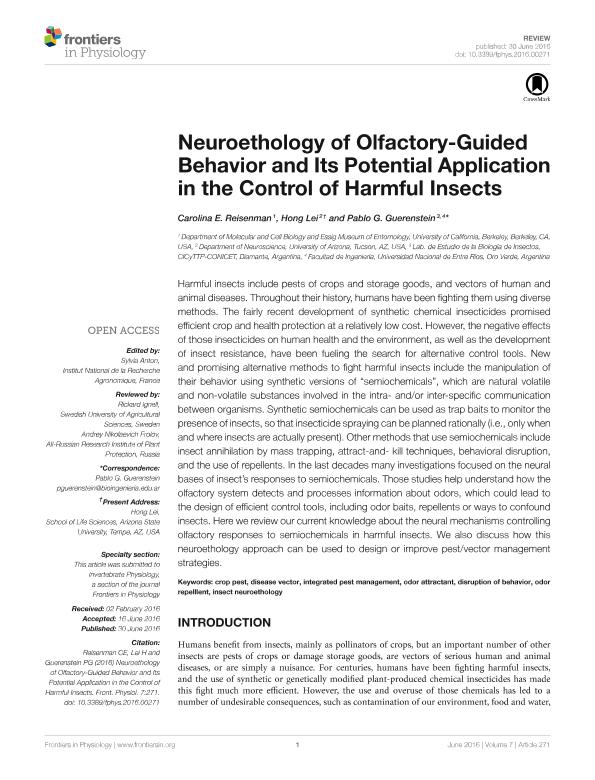Artículo
Neuroethology of olfactory-guided behavior and its potential application in the control of harmful insects
Fecha de publicación:
06/2016
Editorial:
Frontiers Research Foundation
Revista:
Frontiers in Physiology
ISSN:
1664-042X
Idioma:
Inglés
Tipo de recurso:
Artículo publicado
Clasificación temática:
Resumen
Harmful insects include pests of crops and storage goods, and vectors of human and animal diseases. Throughout their history, humans have been fighting them using diverse methods. The fairly recent development of synthetic chemical insecticides promised efficient crop and health protection at a relatively low cost. However, the negative effects of those insecticides on human health and the environment, as well as the development of insect resistance, have been fueling the search for alternative control tools. New and promising alternative methods to fight harmful insects include the manipulation of their behavior using synthetic versions of "semiochemicals", which are natural volatile and non-volatile substances involved in the intra-and/or inter-specific communication between organisms. Synthetic semiochemicals can be used as trap baits to monitor the presence of insects, so that insecticide spraying can be planned rationally (i.e., only when and where insects are actually present). Other methods that use semiochemicals include insect annihilation by mass trapping, attract-and-kill techniques, behavioral disruption, and the use of repellents. In the last decades many investigations focused on the neural bases of insect's responses to semiochemicals. Those studies help understand how the olfactory system detects and processes information about odors, which could lead to the design of efficient control tools, including odor baits, repellents or ways to confound insects. Here we review our current knowledge about the neural mechanisms controlling olfactory responses to semiochemicals in harmful insects. We also discuss how this neuroethology approach can be used to design or improve pest/vector management strategies.
Archivos asociados
Licencia
Identificadores
Colecciones
Articulos(CICYTTP)
Articulos de CENTRO DE INV.CIENT.Y TRANSFERENCIA TEC A LA PROD
Articulos de CENTRO DE INV.CIENT.Y TRANSFERENCIA TEC A LA PROD
Citación
Reisenman, Carolina Esther; Lei, Hong; Guerenstein, Pablo Gustavo; Neuroethology of olfactory-guided behavior and its potential application in the control of harmful insects; Frontiers Research Foundation; Frontiers in Physiology; 7; 271; 6-2016; 1-21
Compartir
Altmétricas




